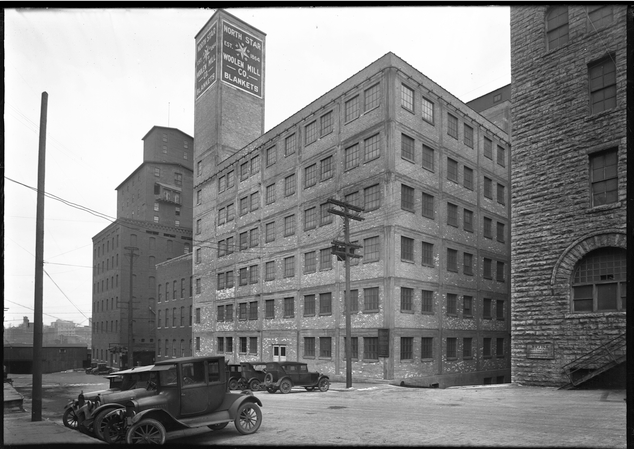Historical Spotlight: The Mill District
The Mill District has been a crucial part of Minneapolis since Minneapolis was founded, but it hasn’t always been the livable neighborhood we love. We’re looking back at the buildings that started the Mill District Revitalization, and the unique history they bring to the area.
Beginnings
The area we now know as the Mill District was a crucial part of Minneapolis’ early history, utlizing the Mississippi River to allow for industry to thrive and goods to be easily transported. Factories and mills popped up along the river bank.
Brighton Development Corporation started the $12 million renovation, the first residential project in what would become the Mill District revitalization. The homes were altered from the original factory, including adding on balconies and decks, and creating some two-story condos. The iconic neon North Star Blankets sign was retained.
Buyers started to sign up in 1998, with 36 initial buyers signing on and then another 50 in the next phase. These were the earliest residence of the Mill District, trailblazers who saw the potential of living by the river and the possibilities of what the old neighborhood could become.
In 1983 the mill was designated as a National Historic Landmark, and in 1991 the abandoned mill had a disastrous fire that collapsed much of the complex. Revitalization began in the last 90s.
Washburn Lofts was converted from the Unity Building, which housed a packing plant and the original Betty Crocker Test Kitchen. The lofts have twenty-two homes, and were designed by Paul Madson and Associates.
NOrth Star Woolen Mill
North Star Woolen Mill was founded by Eastman, Gibson and Company in 1864. The mill specialized in fine woolen blankets, with one of their largest clients being the Pullman Palace Car Company. By 1925 North Star Woolen Mill was the primary woolen blanket mill in the US and underwent extensive renovations. The building was transformed to a warehouse in 1940, and went vacant in 1970.
Washburn Mill
The Washburn “A” Mill complex was first built in 1874. It was the largest of the Washburn Mills, and operated solely on waterpower. The building was subject to a large explosion on May 2nd, 1878, leveling much of the building. The remans of the explosion now make up the Mill City Museum, and the current Washburn Mill was constructed in 1880.
The mill continued to use waterpower until 1960, when construction on Saint Anthony Falls canal and dam made the use impossible. Milling operation stopped in 1965.
The Washburn Complex spurred other buildings as well. The Mill City Museum is built in the ruins of the Washburn Mill Explosion and is dedicated to Minneapolis’ early milling history. In 2003 the Huboldt Flour Mill, part of the Washburn complex, was completed. Designed by Julie Snow, Humboldt Lofts contains two separate wings- the historic renovated units, and the Annex, with 37 new contemporary homes.
The Whitney Landmark Residences was built renovated in 2007, out of what had been the boutique Whitney Hotel. Before existing as a hotel, the building was used a flour mill, and was built in 1879. It is now a highly desired luxury building.
Mill District Now
North Star Lofts and Washburn Lofts were joined by Stone Arch Lofts as the earliest phase of the Mill District Revitalization.
Stone Arch Lofts was constructed in 2000, as one of the final projects by influential Minneapolis architect Paul Madson. Stone Arch Lofts project was awarded the Minneapolis Heritage Preservation Award in 2003 for “celebrat[ing] and enhanc[ing] Minneapolis’s historic character”.
Following the initial slate of buildings, others followed- the Julie Snow-designed Park Avenue Lofts, Zenith Condos, and Bridgewater Lofts.
Construction continues in the Mill District, with buildings such as The Legacy being recently completed.
The Mill District plays host to the Mill City Museum, run by the Minnesota Historical Society. Other notable cultural institutions include the renown Guthrie Theater, designed by architect Jean Nouvel in 2006, and The Loft Literary Center.
The Mill District now hosts abundant parks, restaurants and local shops, and an eclectic mix of both historic and new constructions. What was once a blighted area is now one of the most popular and livable neighborhoods in Minneapolis.
Mill District Listings
Contact us below to view listings in the Mill District, and more!
















